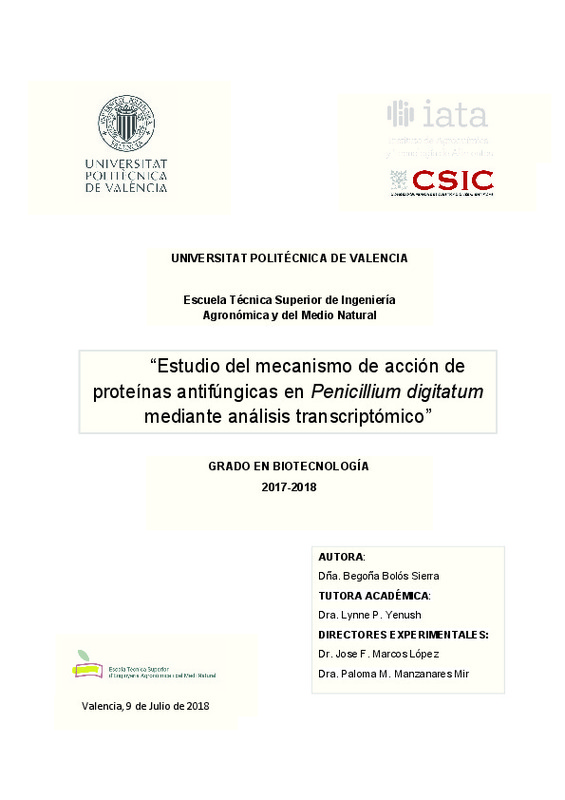|
Resumen:
|
[ES] Las infecciones causadas por hongos representan un importante riesgo para
la salud humana, la producción de alimentos y la seguridad alimentaria. Sin embargo, se
han introducido muy pocos compuestos antifúngicos en ...[+]
[ES] Las infecciones causadas por hongos representan un importante riesgo para
la salud humana, la producción de alimentos y la seguridad alimentaria. Sin embargo, se
han introducido muy pocos compuestos antifúngicos en el mercado de fungicidas en los
últimos años. Por ello, es necesario encontrar nuevas moléculas antifúngicas y a ser
posible con modos de acción diferentes a los de los antifúngicos ya usados. Algunos
hongos filamentosos producen y secretan grandes cantidades de proteínas AFPs
(AntiFungal Proteins) con actividad antifúngica. Estas AFPs son pequeñas, catiónicas y
ricas en cisteínas que forman puentes disulfuro, y tienen un gran interés biotecnológico por
su elevada actividad antifúngica, especificidad y estabilidad. Sin embargo, su mecanismo
de acción antifúngico y su función biológica en el hongo productor apenas se conocen.
Con el objetivo de caracterizar el modo de acción de la proteína antifúngica AfpB sobre el
patógeno de frutos cítricos Penicillium digitatum del cual procede, se ha realizado un
análisis transcriptómico basado en la secuenciación masiva o RNA-seq. Para ello, se han
realizado distintos tratamientos de AfpB sobre la cepa de referencia P. digitatum CECT
20794 (ausencia de AfpB, tratamiento durante 1 ó 3 horas, y crecimiento en presencia de
AfpB) y se ha incluido en el análisis la cepa modificada genéticamente PDSG420 que es
sobreproductora de la proteína antifúngica. Se observaron los efectos de la proteína sobre
el crecimiento del hongo en cada caso. Se determinaron los cambios en el transcriptoma,
obteniéndose un elevado número de genes expresados de forma diferencial (DEG,
Differentially Expressed Gene) en cada tratamiento (hasta 4.143 de los 9.133 anotados en
el genoma) y con similitudes y diferencias en los tratamientos. Se realizó un análisis del
enriquecimiento funcional en ontologías génicas (GO) de los DEGs, para lo que ha sido
necesaria la mejora de la anotación funcional disponible del genoma de P. digitatum.
Como resultado de este trabajo, se han obtenido genes y procesos potencialmente
implicados en la actividad de AfpB y que podrán ser validados experimentalmente en el
futuro. Como ejemplo, el gen PDIG_81760 que es el más inducido por la exposición
continua de la proteína y que codifica una pequeña proteína secretable, rica en cisteínas,
aniónica y con una estructura repetitiva muy peculiar, la cual podría antagonizar la acción
de las AFPs catiónicas.
[-]
[EN] Infections caused by fungi represent an important risk to human health, food
production and food security. However, very few antifungal compounds have been
introduced into the global fungicide market in recent years. ...[+]
[EN] Infections caused by fungi represent an important risk to human health, food
production and food security. However, very few antifungal compounds have been
introduced into the global fungicide market in recent years. There is thus an urgent need for
the development of novel antifungal agents with properties and mechanisms of action
different from existing ones. Some filamentous fungi produce and secrete large amounts of
AFPs (AntiFungal Proteins) with antifungal activity. These AFPs are small, cationic and rich
in cysteines that form disulfide bridges, and have a great biotechnological interest due to
their high antifungal activity, specificity and stability. However, its mechanism of antifungal
action and its biological function in the producer fungus are largely unknown.
In this project, we aim to study the mode of action of the antifungal protein AfpB against the
citrus fruit pathogen Penicillium digitatum, from which the protein was identified, through a
transcriptomic analysis based on RNA-seq. For this, we made different AfpB treatments on
the reference strain P. digitatum CECT 20794 (absence of AfpB, treatment for 1 or 3 hours,
and growth in the presence of AfpB) and the genetically modified strain PDSG420, which
overproduces the antifungal protein, was also included in the analysis. The effects of the
protein on the growth of the fungus were observed in each case. Changes in the
transcriptome were determined, obtaining a high number of differentially expressed genes
(DEG) in each treatment (up to 4,143 of the 9,133 annotated in the genome), with similarities
and differences in the treatments. We made an analysis of the functional enrichment in gene
ontologies (GO) of the DEGs, for which the improvement of the available functional
annotation of the P. digitatum genome was necessary.
As result of this work, genes and processes potentially involved in AfpB activity have been
identified and will be validated experimentally in the future. As an example, the gene
PDIG_81760 that is the most induced by AfpB and codes for a small, cysteine-rich secreted
and anionic protein with a remarkable repetitive structure, that could antagonize the action
of cationic AFPs.
[-]
|







